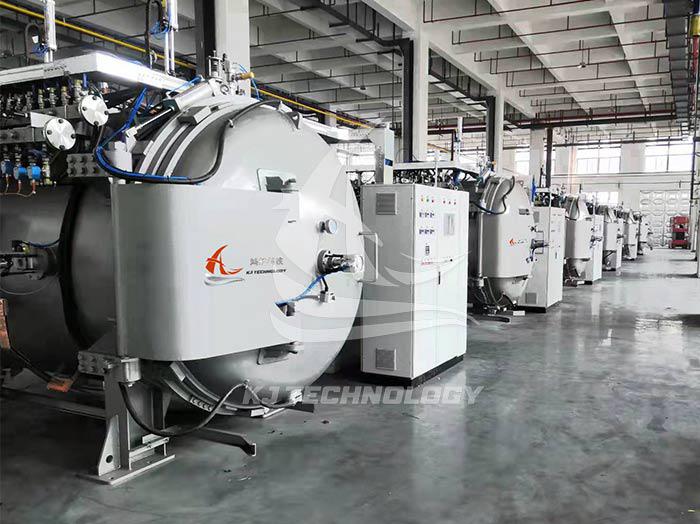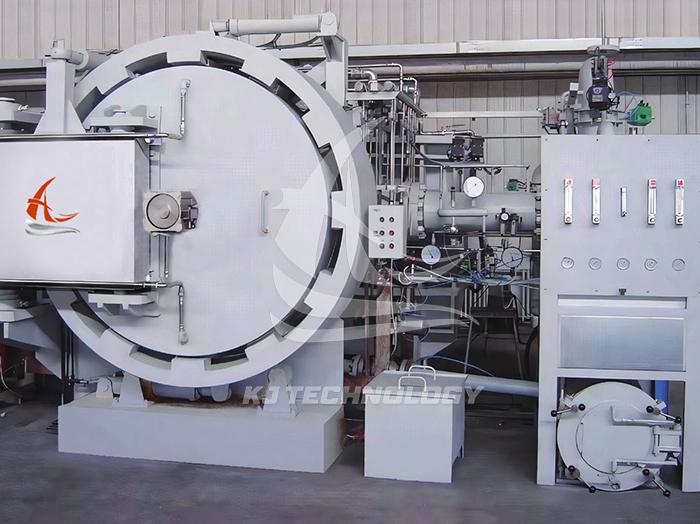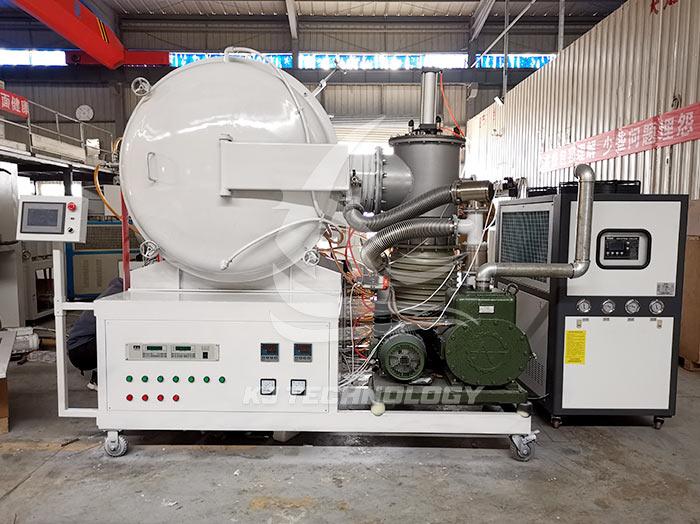What gases can be passed through the atmosphere vacuum sintering furnace?
 05-29-2025 Author: KJ technology
05-29-2025 Author: KJ technology
The atmosphere vacuum sintering furnace achieves sintering environment control through gas injection, and the optional gas types need to be selected comprehensively based on material characteristics, process requirements, and safety. The following are common gas classifications and analysis of applicable scenarios:
1. Inert protective gas
Function: Isolate oxygen, prevent material oxidation or element volatilization, suitable for high-temperature sintering.
Common gases:
Argon gas (Ar)
Characteristics: Strong chemical inertness, large atomic weight, and good protective effect.
Application: Sintering of hard alloys (WC Co), titanium alloys, and high-temperature ceramics (SiC, Si ∝ N ₄).
Case: When sintering tungsten carbide cutting tools, passing argon gas can suppress cobalt phase oxidation, improve hardness and wear resistance.
Nitrogen (N ₂)
Characteristics: Low cost, suitable for the synthesis of non reactive metals or nitrides.
Application: Iron based powder metallurgy, silicon nitride ceramic sintering.
Attention: It may react with certain metals (such as titanium) at high temperatures and should be carefully selected.
2. Reducing gas
Function: Reduce surface oxides of materials, improve purity and performance, suitable for metal or alloy sintering.
Common gases:
Hydrogen (H ₂)
Characteristics: Strong reducibility, capable of removing metal surface oxides (such as CuO, Fe ₂ O3).
Application: Sintering of refractory metals (tungsten, molybdenum) and ultra pure metals (such as high-purity copper).
Risk: Flammable and explosive, requiring explosion-proof devices and hydrogen concentration monitoring systems.
Hydrogen nitrogen mixture (H ₂ - N ₂)
Characteristics: Balance reducibility and safety, reduce the risk of hydrogen explosion.
Proportion: Commonly used H ₂: N ₂=5%~15% (volume ratio), suitable for stainless steel powder metallurgy.
3. Active infiltration of gas
Function: Form a compound layer on the surface of the material through chemical reactions to enhance its performance.
Common gases:
Methane (CH ₄) or propane (C ∝ H ₈)
Function: carburizing treatment, improving the surface hardness and wear resistance of steel parts.
Application: carburizing of tool steel and gears after sintering.
Process: Introduce methane at 950 ℃~1050 ℃ to control the carbon concentration gradient.
Ammonia gas (NH3) or nitrogen hydrogen mixture (N ₂ - H ₂)
Function: Nitriding treatment enhances the corrosion resistance and fatigue strength of the material surface.
Application: Nitriding treatment of mold steel and engine parts.
Case: Ammonia gas is introduced at 500 ℃~600 ℃ to form an iron nitride (Fe-N) layer.
4. Special process gas
Function: To meet specific material or process requirements, such as regulating crystal structure or interfacial reactions.
Common gases:
Carbon monoxide (CO) or carbon dioxide (CO ₂)
Function: Carbon potential control, suitable for sintering carbide ceramics (such as TiC).
Case: When sintering TiC Ni metal ceramics, CO is introduced to adjust the carbon content and avoid decarburization or carbonization.
Rare gases (helium He, neon Ne)
Characteristics: Thermal conductivity superior to argon gas, suitable for ultra-high temperature sintering (such as>2000 ℃).
Cost: High price, only used for special research or high-end manufacturing.
5. Principles and precautions for gas selection
Material Compatibility
Reactive metals (such as titanium and zirconium): Prioritize argon or hydrogen nitrogen mixtures to avoid nitrogen reactions.
Ceramic material: Nitrogen or inert gas to prevent high-temperature decomposition or phase transition.
Process requirements
Carburizing/nitriding: precise control of gas flow rate and temperature is required to form a uniform compound layer.
Ultra pure material: After hydrogen reduction, it needs to be cooled with argon gas to prevent secondary oxidation.
safety
Hydrogen gas: A concentration of ≤ 4% (by volume) is considered a safe range and requires the installation of a hydrogen leak alarm.
Combustible gas: It is prohibited to ignite directly in a vacuum furnace, and inert gas must be filled first for replacement.
economic
Large scale production: Prioritize nitrogen or hydrogen nitrogen mixture to reduce costs.
Laboratory research and development: high-purity argon or rare gases can be selected to meet special needs.
6. Gas inlet method and equipment
Mass Flow Controller (MFC)
Function: Accurately control gas flow rate (such as 0-1000sccm) to ensure process stability.
Case: In the carburizing process, MFC controls methane flow rate with an error of ≤± 1%.
Gas mixing system
Composition: Gas cylinder, pressure reducing valve, mixing tank, pipeline filter.
Requirements: The pipeline should be heat-resistant (such as stainless steel 316L), have good sealing, and prevent gas leakage.
7. Summary and Recommendation
Typical process safety requirements for gas type applicable materials
Low protective sintering of argon/nitrogen hard alloy and high-temperature ceramics
Hydrogen/hydrogen nitrogen mixed gas refractory metals, high-purity materials with high reducibility sintering (explosion-proof, concentration monitoring)
In the carburizing/nitriding treatment of methane/ammonia tool steel and mold steel (gas concentration needs to be controlled)
Rare gas ultra-high temperature ceramics and special alloys require high sintering costs and precise control
Suggestion:
Select base gases (such as argon and nitrogen) based on material properties, and complex processes can be overlaid with reducing or infiltrating gases.
Prioritize equipment equipped with gas mixing and flow control systems to improve process repeatability and yield.
Strictly follow gas safety operating procedures, regularly inspect the sealing of pipelines and valves to avoid accidents.
By selecting the appropriate gas type and injection method, the performance advantages of the atmosphere vacuum sintering furnace can be fully utilized to meet the diverse needs of material preparation.








